The Best Bus Systems In The United States

Buses are often the most convenient form of public transportation available to travelers, and a relatively affordable means of local and long distance transit. In the United States, there are two predominate types of busing services, namely urban (commuter) services and long distance (travel) services that serve the population. Urban bus routes link countless numbers of intercity destinations, and serve around 15,000 cities and towns nationwide. Long distance bus routes cater to more than 3,800 additional destinations across North America as well. Bus tickets can be purchased at any bus terminal or central office, and some can be purchased at train stations with connecting bus routes. In recent years, tickets may also be purchased online via the Internet. In some urban bus lines, such as those serving rural and on-city routes, tickets are only available on board. New York is one of the places in the U.S. where you need to buy a token to ride the bus. This is in contrast to those other locations that offer longstanding seasonal or annual local route bus passes for native commuters to use on a regular basis.
The Most Buses in the US
The US state which has the reputation of having the highest number of registered buses is Texas. The state of Texas's registered bus and commute companies can then be subdivided further into commercial buses, school buses, federal buses, and state, county, and municipal buses. The grand total for Texas alone that allows the state to top our list stands at a whopping 99,482 registered buses. The state with the second most buses in the U.S. is California, not far behind Texas with 92,884 registered buses, followed by Florida, a distant third with 58,774 registered buses. Pennsylvania makes it to the fourth spot with 54,503 registered buses, and then we find Ohio claiming 41,969 registered buses. Georgia (41,776), Illinois (33,571) and Virginia(31,639), also made it towards the top of the list. The US states that claim to have the highest number of registered buses per capita are mostly characterized as being areas where warmer clime prevail for much of the year.
Texas' Highways
The state of Texas has an immense network of highways, which is one of the primary reasons as to why it tops our list. The Gulf Freeway in Houston, for example, was started in 1948 and continues to be repaired and modernized to this day. It is an integral part of the public highway system in Texas, which was estimated to total around 79,535 miles as of 2005. Modern innovations in highway technology utilized within the state of Texas include networks of cameras that help monitor traffic. Another innovation that is common among U.S. highway systems, Texas included, is the use of “frontage roads”, such as access roads, service roads, and feeder roads, which help control and divert traffic between large highways and smaller roadways. The so-called “Texas U-Turns” are another set of unique feature on its freeways, which give cars U-turn access from one frontage road to another despite being situated on the opposite sides of large highways.
A Vital Part of the National Economy
The bus systems in the United States may be under either public or private ownership and administration, including a combination of commercial as well as government-owned bus companies. Nonetheless, regulation, supervision, and funding constraints for all bus companies may ultimately fall under the jurisdiction of the U.S. Department of Transportation. The funding of transportation costs for highway, rail, bus, water, and air are all part of a specific budget given by Congress. State governments are responsible to help meet local transportation needs, and also match federal grants with taxation for the funds and maintenance needs of road and transit networks. This is why some states transportation infrastructures are often far different than those of their neighbors. The economic importance of public transportation to the U.S. cannot be underestimated because of the direct value direct value of such in the movement of goods and movement of people all over the country. Data also shows that this sector is directly responsible for 7.4 percent of all employment in the transportation and moving industry, and transportation employment is the fifth largest employment segment in the U.S.
Number Of Buses By State
| Rank | State | Number of Buses |
|---|---|---|
| 1 | Texas | 99,482 |
| 2 | California | 92,884 |
| 3 | Florida | 58,744 |
| 4 | Pennsylvania | 54,503 |
| 5 | Ohio | 41,969 |
| 6 | Georgia | 41,776 |
| 7 | Illinois | 33,571 |
| 8 | Virginia | 31,639 |
| 9 | North Carolina | 31,278 |
| 10 | Louisiana | 28,975 |
| 11 | Tennessee | 25,810 |
| 12 | New York | 25,738 |
| 13 | Washington | 21,792 |
| 14 | Arizona | 20,989 |
| 15 | New Jersey | 20,245 |
| 16 | South Carolina | 18,080 |
| 17 | Maryland | 15,826 |
| 18 | Wisconsin | 15,307 |
| 19 | Minnesota | 12,438 |
| 20 | Connecticut | 12,379 |
| 21 | Colorado | 11,758 |
| 22 | Massachusetts | 11,049 |
| 23 | Arkansas | 10,395 |
| 24 | Indiana | 10,161 |
| 25 | Kentucky | 9,740 |







